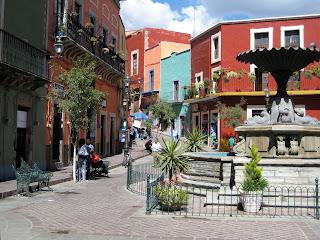 If you were to throw a dart at a map of Mexico, the town of Guanajuato would be the bull's eye. At the geographic center of the country, it earns high points as a vibrant and friendly destination offering more of what Mexico is all about than its sister city of San Miguel de Allende to the east, or its coastal resort cousins to the west.
If you were to throw a dart at a map of Mexico, the town of Guanajuato would be the bull's eye. At the geographic center of the country, it earns high points as a vibrant and friendly destination offering more of what Mexico is all about than its sister city of San Miguel de Allende to the east, or its coastal resort cousins to the west.I traveled to Guanajuato after attending a relative's wedding in a nearby city. Lured by the temperate mountain climate (6,500 feet above sea level), I sought a lively, eclectic locale yet to be invaded by condos, Starbucks and Winnebagos. And though I couldn't describe it is undiscovered by tourists, Guanajuato is large enough and unique enough to have retained its true Mexican character.
You enter the town proper though one of several underground thoroughfares, once used as waterways to shunt the Guanajuato River. Its narrow streets tangle like spaghetti though dramatic gorges, reaching up steep mountainsides like tiny fingers. With old cobblestone walkways as a backdrop, brightly colored buildings cling perilously to canyon walls as the townspeople go about their day-to-day chores seemingly immune to the breathtaking landscape that surrounds them.
At its heart sits Universidad de Guanajuato, a lovely campus that draws full-time and exchange students from all over the world. The prevalence of young people contributes to the town's vibrant and diverse atmosphere. It seems as though Internet cafes, book stores, and coffee shops can be found on every corner.


You'll find everything from Chinese to Pizza within a stone's throw of the town square, including the loyal mainstay, Casa Valdez, right on the Jardín de la Unión. It has a reputation for good food at reasonable prices. However, some of the lesser known restaurants are worth a short evening stroll to seek out. La Capellina at Sopena # 3 is perfect for a romantic evening, as is my favorite, El Abue - a hidden gem at 14 Plaza de San Jose. For Italian, Romanos Restaurant at Hernandez Macias #93 is said to be the most authentic in all of Mexico.
Guanajuato is a mere 30 minutes from Leon's Del Bajio International Airport - easily accessible by car, bus or taxi.

SPECIAL NOTE: Make certain to visit Mercado Hidalgo, the huge indoor marketplace where you'll find clothing, crafts, and wonderfully authentic food. Formerly a bullfighting ring, the Mercado provides a safe and fun detour during your trip.
SAFETY RATING: ****
Aside from the ever-present petty thefts, Guanajuato is a safe place to vacation. Plenty of visible law enforcement and lots of friendly people are around to help if you get lost. Use common sense and do your exploring of isolated areas during the day and with another traveler. The greatest safety concern is when crossing or walking next to the narrow streets. Use caution and keep aware of your surroundings and you'll enjoy all that Guanajuato has to offer.







